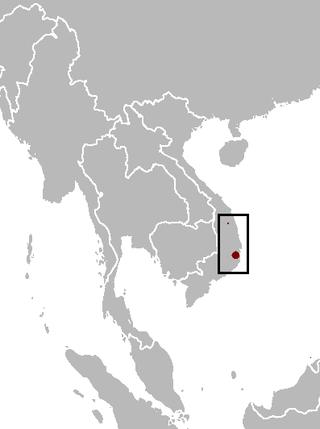
The green pheasant, also known as the Japanese green pheasant, is an omnivorous bird native to the Japanese archipelago, to which it is endemic. Some taxonomic authorities consider it a subspecies of the common pheasant, Phasianus colchicus. It is the national bird of Japan.
Meriania acostae is a species of plant in the family Melastomataceae. It is endemic to Ecuador. Its natural habitat is subtropical or tropical moist montane forests.

Meriania is a genus of flowering plants in the family Melastomataceae. There are about 93 species distributed from Mexico to Brazil and the Antilles.
Meriania almedae is a species of plant in the family Melastomataceae. It is endemic to Ecuador. Its natural habitat is subtropical or tropical moist montane forests. It is listed as vulnerable with the main threat being habitat destruction.
Meriania ampla is a species of plant in the family Melastomataceae. It is endemic to Ecuador. Its natural habitat is subtropical or tropical moist montane forests.
Meriania costata is a species of plant in the family Melastomataceae. It is endemic to Ecuador. Its natural habitat is subtropical or tropical moist montane forests.
Meriania crassiramis is a species of plant in the family Melastomataceae. It is found in Guyana and Venezuela.
Meriania cuneifolia is a species of plant in the family Melastomataceae. It is endemic to Ecuador. Its natural habitat is subtropical or tropical moist montane forests.
Meriania drakei is a species of plant in the family Melastomataceae. It is endemic to Ecuador. Its natural habitat is subtropical or tropical moist montane forests.
Meriania grandiflora is a species of plant in the family Melastomataceae. It is found in Costa Rica and Panama. It is threatened by habitat loss.
Meriania kirkbridei is a species of plant in the family Melastomataceae. It is endemic to Ecuador. Its natural habitat is subtropical or tropical moist montane forests.
Meriania leucantha is a species of plant in the family Melastomataceae. It is endemic to Jamaica.
Meriania maguirei is a species of plant in the family Melastomataceae. It is endemic to Ecuador. Its natural habitats are subtropical or tropical moist montane forests and subtropical or tropical high-altitude shrubland.

Meriania panamensis is a species of plant in the family Melastomataceae. It is endemic to Panama. It is threatened by habitat lossand was listed as Endangered in 1998. As of 2023, its measured population had increased and it was listed as Vulnerable.
Meriania pastazana is a species of plant in the family Melastomataceae. It is endemic to Ecuador. Its natural habitat is subtropical or tropical moist montane forests.
Meriania peltata is a species of plant in the family Melastomataceae. It is endemic to Colombia.
Meriania pichinchensis is a species of plant in the family Melastomataceae. It is endemic to Ecuador. Its natural habitat is subtropical or tropical moist montane forests.
Meriania stellata is a species of plant in the family Melastomataceae. It is endemic to Ecuador. Its natural habitat is subtropical or tropical moist montane forests.

The Vietnam mouse-deer, also known as the silver-backed chevrotain, is an even-toed ungulate in the family Tragulidae known only from Vietnam. It was first described in 1910 by British zoologist Oldfield Thomas, who procured four specimens from Nha Trang in Annam. Little is known about its distribution and ecology. After 1910, the Vietnam mouse-deer was reported next in 1990 near Dak Rong and Buon Luoi in the Gia Lai Province. With increasing hunting pressure, habitat loss due to deforestation and no more reports of the species in the wild, the mouse-deer was feared to have gone extinct. The IUCN listed the species as Data Deficient in 2008. In 2019, a study confirmed the presence of the Vietnam mouse-deer in dry low-lying forests of southern Vietnam with camera trap evidence. The mouse-deer is characterised by a rough coat with a strange double-tone coloration unseen in other chevrotains; the front part of the body is reddish brown and contrasts strongly with the greyish posterior. It has big reddish brown ears, white and dark reddish brown marks on the throat.




